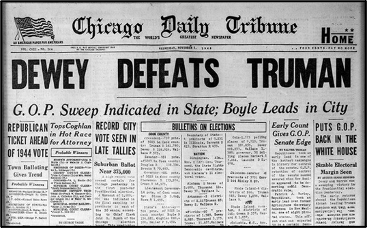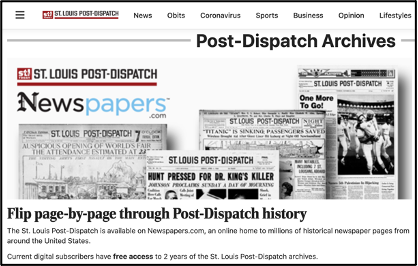News archives: The untapped resource Part 2
Editor’s note: This article is the second of three excerpts of the RJI Fellowship research report: “News Archives: the untapped resource.” See links at end for more.
In talking with more than a hundred news editors and reporters, managers and specialists across the industry for this research, I found great examples of tangible benefits that newsrooms gain from their archives.
At the Baltimore Afro-American, for example, Archive Manager Savannah Wood turned priceless stories and images from their 128-year-old newspaper archive into an enlightening book about the experiences of Black women in Baltimore during the suffrage movement in the 1920s, released to coincide with the 100th anniversary of the 20th Amendment in the summer of 2020.
I found numerous examples of the seemingly endless gold mine of news stories from the past that echo today’s headlines, often in eerily similar ways. Many newsrooms, for example, found similarities to the Spanish Flu Pandemic of 1918 in their community’s experiences in the COVID-19 pandemic. Or the numerous media outlets that saw parallels in their own local coverage of the Watergate tapes of the 1970s to modern coverage of President Trump’s 2019 Ukraine phone calls and subsequent impeachment. At the Washington Post, reporter Gillian Brockell and colleagues tap these kinds of past-present connections on an almost daily basis to bring much-needed context to today’s breaking news headlines for readers across the country.
I also encountered wonderful, if more rare examples such as the lightning flash that went off when Photo Editor Marianne Mather realized that she had stumbled across critical century-old glass plate negatives in the Chicago Tribune’s sub-basement, clues that she and journalist Kori Rumore untangled to reveal the surprising backstory to one of America’s most popular Broadway musicals and Hollywood movies.
Or the hopeful story of the Detroit Tigers “Roar of ’84,” told in film through the unique visual insights into key plays throughout that World Series winning season, shot by America’s first female Major League Baseball photographer and carefully preserved by her ever since.
It’s my hope that these and many more examples detailed in the report will be of interest to anyone in the news industry and the public who worry about what is happening to the growing flood of news content racing past us every day after it’s published, broadcast, posted or streamed. This is intended especially for those within the news industry who are concerned about saving this dizzying explosion of digital news channels, news services and social media content we struggle to create and to consume, and who seek inspiration from other news organizations in their own efforts to do a better job in preserving today’s surprisingly fragile digital journalism.
Many ways to tap news archives
The goal of this project was to find the best examples available of how newsrooms are making use of their past content in ways that provide real benefits: from subscriber incentives to social media traffic to special editions and books and even films. Regardless of the kind of benefit, the goal was to understand the wide range of ways that newsrooms are now gaining advantages through their archives, either financially, in reader engagement and other metrics, or in service to readers and their communities.
In addition, I wanted to learn how these efforts started, what sparked them, how they are accomplished, what tools or systems were needed, what policies or staff positions, funding or grants were required. And how well they worked, what kind of revenue they generated, how much traffic, how many new subscribers, and so on. The idea was to see how well these ideas could be replicated by other news organizations in the US or other countries.
To help organize and make sense of these examples, I grouped them into five general types, or categories, shown below with an outline of the similarities in content utilized and benefits.
Types of archive benefits
1. Perspective on current news

This category is first because of its importance. After investigating the practice of news preservation in the digital era, it’s clear newsrooms that routinely tap their archives to bring perspective to readers on the breaking news of the day are fulfilling one of the most important and effective purposes for preserving news content: to provide background, context and meaning behind today’s news stories.
This is a critical function of a news media in our society, providing an independent view on the events of today, as well as events of that past that shape today’s headlines. It’s the role of a free press, independent of government, business, religion or other institutions. An essential element of this role is the ability to look into the past, into the public record of each local community, as covered at the time by local, independent news organizations. This is the irreplaceable role of the news archive.
This report provides many examples of these types of efforts, including the stellar practices of the Washington Post’s Retropolis series of stories that follow the news closely, providing perspective on recent topics ranging from the Tulsa “Black Wall Street” massacre of 1921 to the racist origins of the US Senate filibuster.
Many of the best practitioners of this kind of deep perspective journalism are avid aficionados of news archives. “History is an angel being blown backwards into the future,” says the Twitter bio for Gilllian Brockell of the Post’s Retropolis series.
Also active is the Chicago Tribune, which ran a fascinating Nov. 3, 2020 online spread showing Tribune front pages from all 27 presidential elections of the past century, including the famous “Dewey Defeats Truman” front page from 1948, an early edition, incomplete result which, as America now knows too well, can change during the course of later vote counting.
A key element of this category of content, in its best form, is that it applies a perspective on news that is most meaningful for that community. Examples include the local Tampa Bay Tribune impeachment editorial from 1974 about President Nixon, and the KOIN-TV story about a far-sighted health director whose actions saved an Oregon community from far worse devastation from the 1918 pandemic.
2. Special projects, unique content
This category covers specialized content services or projects that usually involve unique content and longer time frames than daily or breaking news. This includes special online presentations, pages, web or print sections, books, magazines or video or film, often highlighting an important or famous (or infamous) event from the past, including anniversary coverage.
One of the most creative examples I encountered is the 30-minute documentary film that the Detroit Free Press produced on “The Roar of ‘84,” highlighting inside-the-newsroom details on how they covered the Detroit Tigers the year they won it all, timed to coincide with the induction of a player from that era into the Major League Baseball Hall of Fame.
We also share details of the Baltimore Afro American book on women’s suffrage, the New York Time’s inviting Past Tense photo essays, and the lavishly illustrated Chicago Tribune 2020 book, “He Had It Coming,” about the female crime reporter whose work was turned into a hit musical decades later.
The key distinguishing element in this set of examples is that they are largely one-time activities, a special product ranging from film to hardcover books that are produced at one point in time. They are also most often based on content that is unique to that news organization and to that city or region, with special meaning for local residents.
3. High-reader interest, traffic, engagement
This genre of content is one that evolved over the years from the old-style “Today in history” blurbs that many newspapers and radio stations used to run. Nowadays, this takes the form of often highly popular social media channels, especially Instagram and Twitter, with images and video clips that at some newsrooms attract large followings and can go viral.
The Vintage Tribune photos from the Chicago Tribune are one highly popular example on both their website and Instagram, along with high-traffic Instagram sites run by The New York Times, the Los Angeles Times and many more.
One of the key factors for this category of content is the channel: using highly popular social media services to attract large followings of readers and viewers, including many in younger age groups who often do not spend time with primary news channels such as news websites, TV and radio broadcasts and print newspapers or magazines.
4. Subscription incentive, financial/revenue benefits

This approach is in use by a growing number of news organizations, especially as the business model for local news shifts from advertising to digital subscriptions. Services that enhance the value of subscriptions are becoming more and more popular, building on digital news access to add e-editions, special or premium newsletters, archive access and subscriber-only pricing on special content such as books, magazines, and other premium content. These are also sometimes referred to as reader-loyalty programs and are often used in sales offers for new subscribers. The model for archive-access benefits is The New York Times, which invested heavily to develop the highly popular Times Machine, a service available at no additional cost to any NY Times subscriber.
One key element of this group is the growing use of so-called news paywalls, which limit access to free news content and encourage ongoing subscribers, especially in the digital space where premium incentives such as archive access can be offered through web or app links to help build a subscriber base.
5. Community service functions
This last category covers a range of options that involve some kind of specialized community service, company or institution such as a university or public library, museum, non-profit or other types of community groups. Great examples of this genre include the Chicago Sun-Times photo archive now housed at the Chicago History Museum, a huge collection that includes images from the long-closed Chicago Daily News that were once thought to be lost; and a once-endangered Ebony and Jet Magazine photo archive, a priceless resource for images of Black America in the 20th Century, saved from oblivion in 2019 through a cooperative non-profit.
This is part of a series of excerpts of the RJI Fellowship research report: “News archives: The untapped resource.” Here are links to all three parts:
This is part of a series of excerpts of the RJI Fellowship research report: “News archives: The untapped resource.” Here are links to all three parts:
- Part 1 – “Value, importance of good news archives can’t be overstated”
- Part 2 – “Five ways that newsrooms find great value in news archives”
- Part 3 – “Creative examples show deep value of news archives” — Coming July 28, 2021
Read the full report, with full details on ways newsrooms are tapping their news archives.
Also, don’t miss the larger, in-depth research project for which this was a companion report, “Endangered But Not Too Late: The State of Digital News Preservation.”

Comments